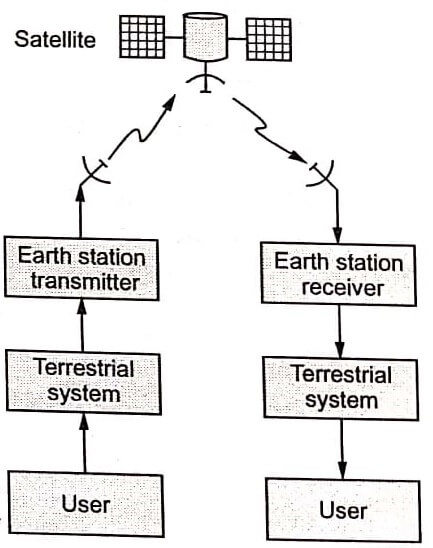Fig shows the block diagram of satellite communication system. The satellite consists of transmitters as well as receivers. They are also called as transponders.

The satellite receives signals from earth station transmitter, processes them (filtering, amplification) and transmits towards earth station receiver.
The terrestrial communication system transmits or receives signals to users. It acts as a link between users and satellite earth stations.
The direct broadcast satellites such as direct to home (DTH) TV transmission can directly transmit to users. Satellites phones can directly communicate with satellites.
Commonly satellites use a frequency band of 500MHz bandwidth. It uses 6GHz uplink frequency and 4GHz downlink frequency.
The 500MHz bandwidth is divided into 12 channels of approximately 40MHz each. And every channel transmits 5 – 10 W power.
The 12 channels use 12 transponders on the satellite. They can carry upto 1500 analog voice signals.
Introduction
The first satellite was launched in 1957 and then the satellite communication system opened up new area for communication. We know the limitation of terrestrial communication. The line of sight communication range was limited by the curvature of the earth, therefore long distance communication was required to adopt some other solutions. The greatest advantage of satellite communication is that there is direct line of sight communication direct down to the earth. Also the earth station can directly communicate to the satellite. This advantage of satellite communication solved many problems in the field of communication.
The long distance communication requires the cables and repeaters. Satellite communications does not need any cables or repeater stations. With the satellite it is possible to cover a specific limited area for transmission. This area is called foot print area of the satellite or coverage area. This area can be as low as few square kilometres and as high as 40% of the total earth surface facing satellite. Also it is possible to control the effective power radiated in the coverage area. The earth station within this area can communicate directly to the satellite. With the satellite to satellite communication it is possible to communicate with any point of the globe. Because of such complete coverage of earth surface, the communication and information exchange between various countries has become very simple. Since the satellite to satellite communication is quite above the earth surface, there is no electromagnetic interference generated on the earth. The attenuation due to earth and all these factors are overcome.
| Read More Topics |
| Space division multiple access |
| Frequency hop spread spectrum |
| Multiple access techniques |





